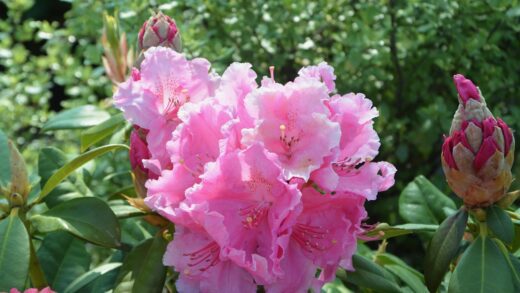The Chinese empress tree is fundamentally a sun-loving species, and its light requirements are a defining aspect of its character and cultivation. Its ability to achieve such rapid growth is directly powered by its capacity to photosynthesize, a process that relies entirely on an abundant supply of direct sunlight. Providing the right light conditions is therefore not just beneficial but absolutely essential for the tree to thrive, produce its magnificent display of spring flowers, and develop a strong, well-proportioned structure. Insufficient light will lead to a host of problems, from weak, leggy growth to a complete absence of the blooms for which it is so highly prized.
For optimal health and performance, a Paulownia tomentosa must be planted in a location that receives full sun. In horticultural terms, “full sun” is defined as a minimum of six to eight hours of direct, unfiltered sunlight per day during the growing season. In its native habitat, it often colonizes open, disturbed areas where it can capitalize on the lack of competition for light. This preference is hardwired into its biology, and it is a crucial factor to consider when selecting a planting site in a garden or landscape setting. A spot on the south or west side of a property, away from the shade of large buildings or other mature trees, is typically ideal.
The impact of sunlight extends beyond just fueling growth; it also plays a critical role in flowering. The empress tree sets its flower buds in the autumn on the previous year’s wood. These buds then overwinter on the bare branches and burst into bloom in the spring before the leaves emerge. For these flower buds to form in sufficient numbers and to develop properly, the tree needs the high energy levels that can only be generated through a full season of exposure to strong sunlight. A tree planted in a shady location may grow, albeit slowly, but it is very unlikely to ever produce a significant floral display.
Furthermore, adequate sunlight contributes to the overall structural integrity of the tree. When a tree receives light from all directions, it tends to grow in a balanced, symmetrical manner. In contrast, a tree that is shaded on one side will stretch and grow disproportionately towards the available light source, a phenomenon known as phototropism. This can result in a lopsided, weakened structure with elongated, spindly branches that are more susceptible to breaking in high winds or under the weight of snow. Therefore, providing full sun is a key component of preventative care, helping the tree to build a strong and resilient frame.
The effects of insufficient light
When a Chinese empress tree is deprived of the full sun it craves, the consequences become apparent in several ways. The most immediate and noticeable effect is a significant reduction in its growth rate. The tree’s legendary speed is contingent upon its ability to maximize photosynthesis, and in shady conditions, this process is severely hampered. Instead of the vigorous, multi-meter growth expected in a season, the tree will be slow and stunted, never reaching its full potential in either size or stature. This lack of vigor also makes the tree more susceptible to secondary problems like pests and diseases.
More articles on this topic
One of the most characteristic symptoms of a light-starved tree is etiolation, which results in weak, “leggy” growth. The tree will develop long, thin, and spindly branches as it stretches desperately towards the nearest source of light. The spaces between the leaves on the stem, known as internodes, will become elongated. This type of growth is structurally weak and prone to snapping. The leaves themselves may also be smaller and a paler shade of green than those on a tree growing in full sun, as the plant produces less chlorophyll in low-light conditions.
Perhaps the most disappointing consequence for many gardeners is the impact on flowering. A Paulownia tomentosa growing in partial or full shade will produce very few, if any, flowers. The production of flowers is an energy-intensive process for a plant, and if the tree is not able to generate enough energy through photosynthesis due to lack of light, it will prioritize its resources for basic survival and vegetative growth. The spectacular display of fragrant lavender blossoms that is the tree’s main ornamental feature will be completely absent, defeating one of the primary reasons for planting it.
In addition to poor growth and a lack of flowers, insufficient light can also exacerbate problems with fungal diseases. Shady, damp conditions with poor air circulation create the perfect environment for pathogens like powdery mildew and various leaf spot fungi to thrive. A tree growing in full sun, by contrast, benefits from the drying effects of the sun and better air movement, which helps to keep the foliage dry and less hospitable to fungal spores. Therefore, a sunny location contributes not only to the tree’s growth but also to its overall health and disease resistance.
Site selection for optimal sun exposure
Given the critical importance of sunlight, the process of selecting a planting site for an empress tree must be undertaken with careful consideration. Before you even dig a hole, it is essential to observe the potential planting area throughout the day to accurately assess how many hours of direct sunlight it receives. Remember to account for the changing angle of the sun throughout the seasons; a spot that is sunny in the summer may be shaded in the spring or autumn when the sun is lower in the sky. Also, consider the future growth of nearby trees and shrubs, which could eventually cast shade on your empress tree.
More articles on this topic
The ideal location will be an open area that is free from the shadow of buildings, dense tree canopies, and other tall structures. A position in the middle of a large lawn or in a wide, open border is often a good choice. When planning the layout of your garden, think of the empress tree as a major structural element that needs its own “airspace” and light-window. Planting it too close to a house, for example, will not only create problems with its roots and branches later on but will almost certainly result in one side of the tree being heavily shaded for a significant portion of the day.
You must also consider the empress tree’s own future shadow. Given its rapid growth and large ultimate size, with a canopy that can spread 12-15 meters, it will eventually cast a considerable amount of shade itself. This needs to be factored into your garden design. Do not plant it where its future shade will negatively impact other sun-loving plants, a vegetable garden, or a patio area where you enjoy sitting in the sun. Instead, use its shade-casting potential strategically, for instance, by planting it to the west of your house to provide cooling shade from the hot afternoon sun in the summer.
In smaller urban or suburban gardens, finding a location that provides a full eight hours of direct sun can be a challenge. In such cases, you must prioritize. A location that receives strong morning and midday sun is generally preferable to one that only gets a few hours of late afternoon sun. While the tree might not perform as spectacularly as one in an open field, maximizing the available sunlight is key. If a full sun location is simply not available, it may be more prudent to choose a different species of tree that is better adapted to partial shade, rather than trying to force the empress tree to grow in unsuitable conditions.
Light needs at different life stages
The light requirements of the empress tree are consistently high throughout its life, but they are especially critical during its early stages of development. When growing the tree from seed, light is actually a requirement for germination to occur. The tiny seeds should be surface-sown and not covered with soil, as they need exposure to light to sprout. Once the seedlings have germinated, they require very bright, indirect light or filtered sunlight to grow strong without being scorched. As they develop into young saplings, they should be gradually acclimated to direct sunlight before being planted out in their final, full-sun position.
For a newly planted young sapling, full sun is vital for driving the rapid growth needed to establish a strong root system and a sturdy trunk. This initial period of establishment is when the tree builds the foundation for its entire life, and abundant solar energy is the fuel for this crucial construction process. A young tree planted in a shady spot will struggle to establish, remaining small and weak, and will be much more vulnerable to winter damage, drought stress, and other environmental challenges. Ensuring a young tree gets maximum sun exposure from day one is the best investment you can make in its future health.
As the tree matures, its need for full sun does not diminish. A mature empress tree requires a full complement of daily sunlight to maintain its large canopy, support its massive leaf area, and produce the energy reserves needed for its prolific flowering and seed production. Even for a large, established tree, the encroachment of shade from a newly constructed building or the growth of a neighboring tree can lead to a decline in its health. The lower branches may begin to die back, the canopy can become thin and sparse, and flowering will be significantly reduced on the shaded parts of the tree.
It is worth noting that while the empress tree demands full sun for its foliage, its root system benefits from being kept cool and moist. This is one of the reasons why applying a thick layer of organic mulch over the root zone is so beneficial. The mulch helps to insulate the soil from the direct heat of the sun, reducing water evaporation and creating a more stable environment for the roots. This combination of a sun-drenched canopy and a cool, shaded root run provides the ideal conditions for this magnificent tree to flourish.


















